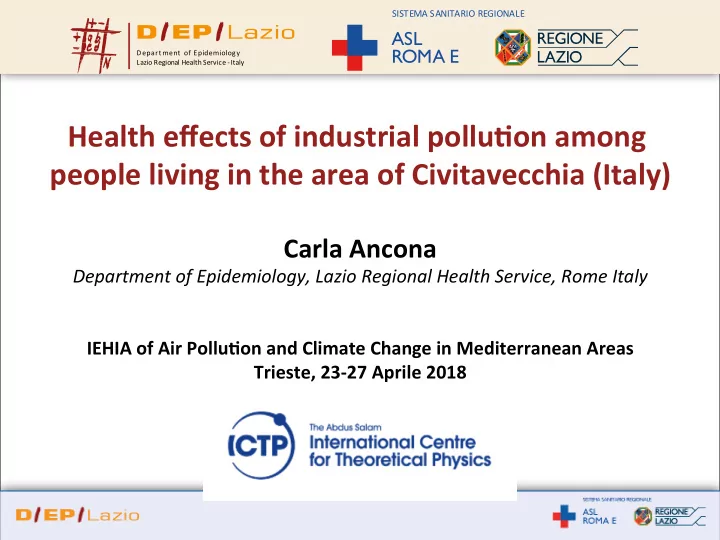

SISTEMA SANITARIO REGIONALE ASL ROMA E Depart ment of Epidemiology Lazio Regional Health Service - Italy Health effects of industrial pollu3on among people living in the area of Civitavecchia (Italy) Carla Ancona Department of Epidemiology, Lazio Regional Health Service, Rome Italy IEHIA of Air Pollu3on and Climate Change in Mediterranean Areas Trieste, 23-27 Aprile 2018
Epidemiological studies in industrial areas and contaminated sites ü Mul%ple sources ü Different pathways ü Variable %me of contamina%on ü Popula%on size (and size of the exposed groups) ü Socioeconomic status (environmental jus%ce) ü Occupa%onal exposure ü Outcomes defini%on and data collec%on ü Enviromental worries and media pressure
Civitavecchia traffic Coal thermoelectric power plants Tarquinia Gas/Oil Coastal biomass heating deposits oil Civitavecchia Rome Tolfa Civitavecchia Coal/Oil Allumiere Cement factory harbor Santa Marinella
Background Epidemiological studies carried out in the Civitavecchia district showed high mortality and morbidity risk for lung cancer, mesothelioma and respiratory diseases both among workers and general population. • Harbor workers (Bonassi 1985) • Electric power plant workers (Forastiere 1989) • Seamen and ship workers (Rapiti 1992) • Respiratory diseases in children (Forastiere 1992, 1994) • Lung cancer case-control study (Fano, 2004)
data about individual exposure to pollutants from the different sources were not available
dispersion models HBM VS
Dispersion model
Metodi: Indicatori di esposizione PM 10 NO x PM 10 PM 10 coal power plat Harbor Traffic (cars biomass +trucks) burning Lagrangian model SPRAY
Coal power plant– PM Emissioni Autorizzate 2012 µ g/m 3
Harbour
Civil hea@ng (biomass burning) – PM µ g/m 3
Urban traffic – NOx µ g/m 3
HBM Biomonitoring the concentrations of metals in blood or in urine allows to assess the human contamination to environmental pollutants through all routes of Contamination of soil, exposure plants and animals Disease or not disease Food chain
Population municipality registers Tarquinia Tolfa Civitavecchia Allumiere Santa Marinella 71.362 people (18+ years)
ABC study Period: 2013-2014 Popolation: A sample of 2000 residents (age 35-69) was randomly selected from the Municipal Register's data and their residence addresses were geocoded.
ABC study partecipants Contacted 1790 613 refuse Respondents 1177 (65,7%) Availability of medical examinations 1141 (96,9%) Blood 1131 (96%) Urine 1128 (95,8%) Sample Availability Nails 435 (36,9%) Hair 395 (33,6%) Respondents Availability of medical examinations Sample
Exposure assessment ( Biomarkers ) Biomarkers NHANES - USA Other literature Biomarkers Metabolite Other literature Antimony (Sb) coal combustion diet; drinking water Acid S-phenylmercapturic smoking; traffic; industrial benzene coal plant; harbor; diet; drinking (SPMA) pollution Arsenic (As) water Cotinine Nicotine smoking coal combustion; Smoking; diet; drinking water; Berillium (Be) Metabolite PAH Other literature smoking hazardous waste coal combustion; 1-OH pyrene traffic Cadmium (Cd) Coal plant; harbor; smoking 1-OH naphthalene smoking smoking 2-OH naphthalene smoking coal and oil combustion; Cobalt (Co) dietary supplements 1+9 OH phenanthrene traffic; combustion traffic Coal plant; harbor; traffic; galvanic 2-OH phenanthrene traffic; combustion Chrome (Cr) industry; smoking; diet 3-OH phenanthrene traffic; combustion Cupper (Cu) Coal plant, harbor; traffic 4-OH phenanthrene traffic; combustion Iridium (Ir) traffic 2-OH fluorene combustion Lead (Pb) coal combustion Harbor; diet; drinking water Manganese (Mn) harbor; combustion; diet Mercury (Hg) coal combustion; diet coal plant; diet Molybdenum (Mo) coal plant; diet; drinking water Coal combustion; harbor; Nickel (Ni) traffic; smoking; diet; jewelry; detergents Palladium (Pd) traffic traffic Platinum (Pt) traffic Rhodium (Rh) Traffic Tallium (Tl) coal combustion coal combustion coal combustion; petroleum; Tin (Sn) consumption of canned foods combustion; cement plant; Tungsten (W) drinking water Vanadium (V) harbor; fossil fluels; diet Zinc (Zn) combustion; traffic; diet
Geometric mean of urinary (adjusted for urinary creatinine) and blood concentration of heavy metals of the sample (SD, median 95th-5th percentile) and comparison with other studies. POPOLAZIONE Italia 2009 Torino* NHANES ABC totale antimonio (Sb) µg/gr creat 0.06 0.06 0.07 [2005] 0.05 [2013] arsenico (As) µg/gr creat 19.36 16.86 16.7 [1990] 8.15 [2013] berillio (Be) µg/gr creat 0.13 0.15 0.4 [1990] <0.072 [2013] cadmio (Cd) µg/gr creat 0.42 0.66 0.81 0.18 [2013] cobalto (Co) µg/gr creat 0.23 0.16 0.24 0.38 [2013] cromo (Cr) µg/gr creat 0.13 0.15 0.21 1.0 [2000] iridio (Ir) ng/gr creat 0.88 1.66 2 [1990] mercurio (Hg) µg/gr creat 1.17 1.46 1.92 0.40 [2013] manganese (Mn) µg/gr creat 0.11 0.12 0.22 0.137 [2012] molibdeno (Mo) µg/gr creat 38.34 36.9 38.6 [2012] nichel (Ni) µg/gr creat 0.81 0.88 0.87 2.4 [2000] palladio (Pd) µg/gr creat 16.02 23.01 piombo nel sangue (Pb) ng/l 20.19 18.27 26.4 10.7 [2013] platino (Pt) ng/gr creat 2.57 3.1 2 [2004] <0.009 [2013] rame (Cu) µg/gr creat 7.05 10.07 12.9 0.393 [2012] rodio (Rh) ng/gr creat 16.65 18.37 15 [2004] stagno (Sn) µg/gr creat 0.32 0.55 0.9 0.665 [2012] tallio (Tl) µg/gr creat 0.4 0.26 0.07 [1994] 0.16 [2013] tungsteno (W) µg/gr creat 0.14 0.08 [2005] 0.074 [2012] vanadio (V) µg/gr creat 0.04 0.03 0.14 zinco (Zn) µg/gr creat 283.22 362.81 356 231 [2000] * relazione programma SPoTT (10)
Associazione tra indicatori di esposizione e concentrazione urinaria di metalli pesanti - GMR, 95% I.C. 95°p-5°p=0.005 95°p-5°p=15.2 1.17 (1,00-1.38) 1.16 (0.99-1.35) 1.14 (0.99-1.30) 1.11 (0.99-1.24) 1.10 (0.96-1.27) 1.08 (0.95-1.24) 95°p-5°p=4.22 95°p-5°p=0.065 1.16 (0.98-1.38) 1.19 (1.03-1.37) 1.31 (0.98-1.76) 1.06 (0.98-1.15) 1.11 (1.00-1.23) 1.14 (1.05-1.24) 1.09 (0.97-1.22) 1.09 (0.97-1.22) 1.03 (0.98-1.09) GMR aggiustate per concomitanti esposizioni ambientali, creatinina, periodo di arruolamento, caratteristiche demografiche, fattori di rischio ( backward procedure )
Conclusion: Coal combustion (power olant biomass burning): Cadmium – Mercury – Tallium – Antimony – Berillium – Manganese – Molibdenum – Cupper– Tungsten Traffic (road and ships): Platinum – Rhodium – Arsenic Dispersion models are a valid tool for estimating the individual exposure of populations living in industrially contaminated areas .
SISTEMA SANITARIO REGIONALE ASL ROMA E Depart ment of Epidemiology Lazio Regional Health Service - Italy Health effects of industrial pollu3on among people living in the area of Civitavecchia (Italy) Carla Ancona Department of Epidemiology, Lazio Regional Health Service, Rome Italy IEHIA of Air Pollu3on and Climate Change in Mediterranean Areas Trieste, 23-27 Aprile 2018
Recommend
More recommend